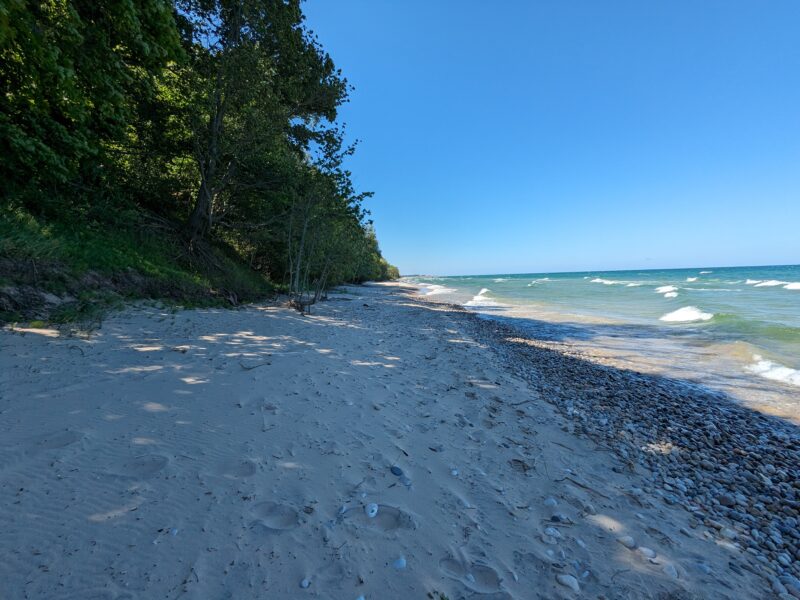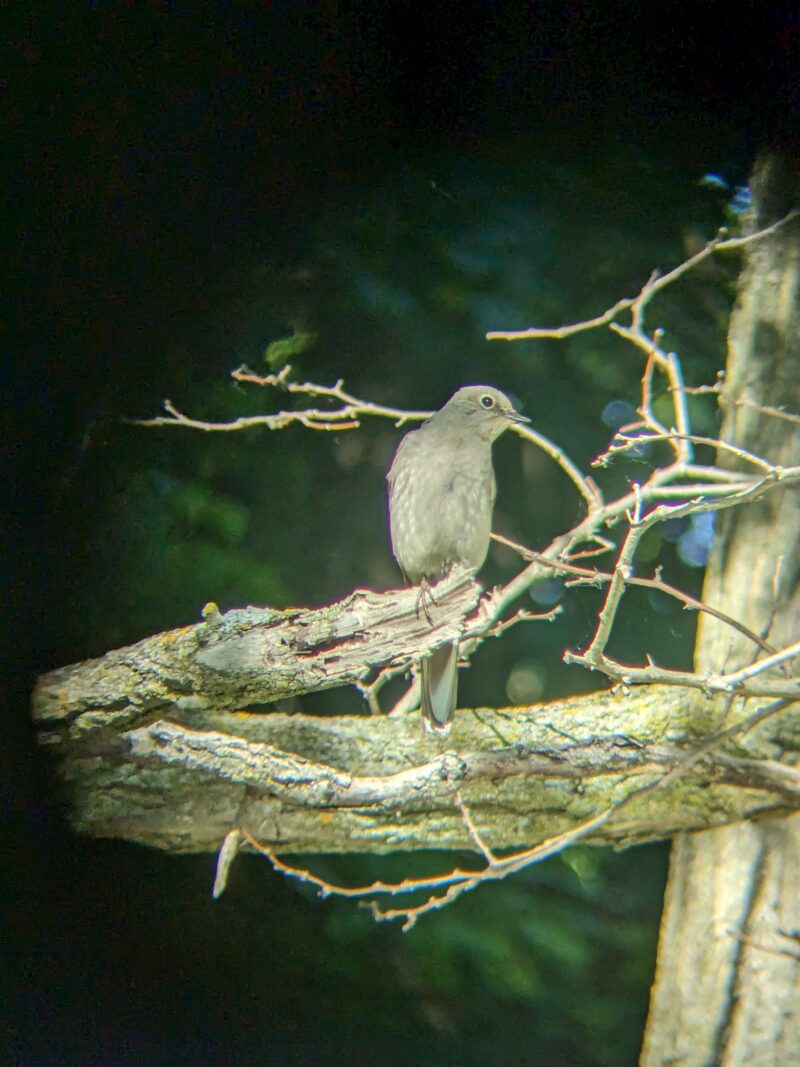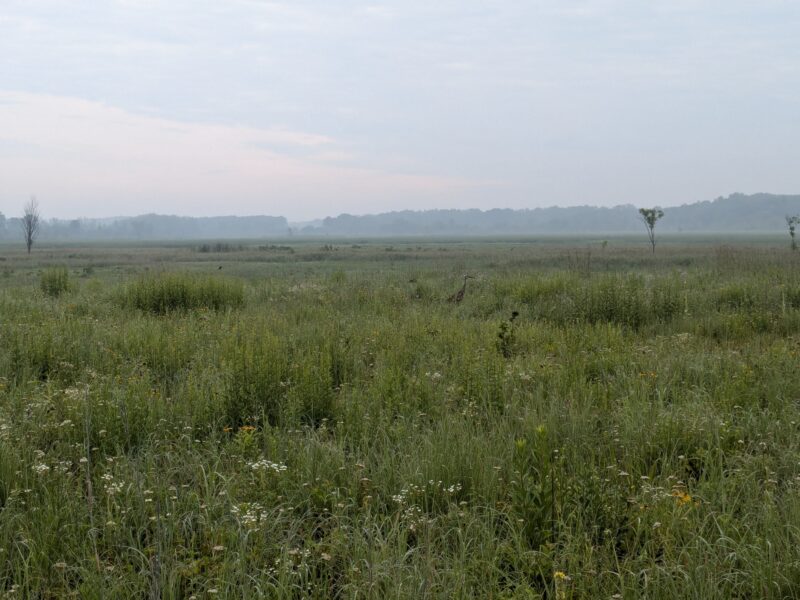Conservation Manager Chad Machinski, M.S., joined the Michigan Audubon team in March of 2023 and has made great progress in reviving the stewardship of MA’s sanctuaries and engaging with our dedicated volunteers ever since. To help you stay connected with the work being done, he will be presenting regular online updates about activities going on at them: birds seen or heard, conservation work, improvements, interesting plants, and more.
Although June passed without any updates from the conservation team, I will do my best to provide a quick rundown of noteworthy events in addition to my July updates. So sit down, grab your coffee or tea, and give your eyes a good rub before diving in to read.
KIRTLAND’S WARBLER TOUR
In early June, our whole office headed up to Kirtland’s Warbler territory to meet up with our Kirtland’s Warbler tour guide, Brant Georgia, in the hopes of getting everyone on a Kirtland’s, which would be a life bird for myself and most others. While we could hear a few singing just off the road, they were all obscured by the dense jack pines that are their summer home. As we walked to our next spot, a male hopped to a snag and began belting his song! He continued to grace us with wonderful views even after dipping back into the scrub multiple times. If you haven’t yet had the opportunity to see a Kirtland’s Warbler, I highly recommend attending one of Michigan Audubon’s tours next year. It is such a treat to see a bird that is so very habitat-specific.
LAKE BLUFF BIRD SANCTUARY
I headed to our Lake Bluff Bird Sanctuary in Manistee the following week. This would be my first visit to the sanctuary. I met up with a few folks from Lake Bluff Farms, who now own the manor that our sanctuary surrounds. The property has beautiful views of Lake Michigan and a wonderful northern mesic forest on the east side. While there was once access to the beach, changes in water levels over the past several years have eroded access via stairs. Replacement of the stairs so that visitors can gain beach access will be in the future for this property. While much time was spent at the sanctuary, the city of Manistee offered some unexpected bird opportunities. While walking to dinner that evening, a Townsend’s Solitaire was found in a neighborhood, simply perched on a low-hanging black locust limb. This is a frequent vagrant in Michigan from the west and seems to be more commonly seen in Michigan in the winter months. Chimney Swifts were bountiful in the skies over downtown Manistee. The historic downtown chimneys and Victorian houses offer plenty of nesting and roosting opportunities for this declining species. In addition, a sizable Purple Martin colony was found behind a business. Michigan Audubon is attempting to track Purple Martin colonies, and this location represents one of the few northern colonies registered with us.

Photo of beach looking south at Lake Bluff Bird Sanctuary. Photo by Chad Machinski

From left to right: Chad Machinski (MA Conservation Manager), Jim Cowan (Lake Bluff Farms), and Bill Zielinski (Lake Bluff Farms) stand in front of the State Champion giant sequoia at Lake Bluff Farms. Photo by Murphy Harrington

Townsend's Solitaire, a western species, seen in Manistee. Photo by Chad Machinski
PURPLE MARTINS
Speaking of Purple Martins, June 22 saw the Purple Martin Party co-hosted by Michigan Audubon, Jackson Audubon Society President Connie Spotts, and Purple Martin landlord expert Penny Briscoe. Several Purple Martin landlords from around the state gathered to meet, share their experiences, and see Connie’s large and successful Purple Martin colony. It was great to meet folks in person with whom I’ve only corresponded over email, and it was great to hear success stories from landlords. If you or anyone you know has a Purple Martin colony, please consider registering the colony and submitting end-of-season nest reports to Michigan Audubon here.

Connie Spotts pulling out a Purple Martin chick to show to party attendees. Photo by Chad Machinski

Looking west, down the boardwalk at Otis Farm Bird Sanctuary at dusk. Photo by Chad Machinski
OTIS FARM BIRD SANCTUARY
Sanctuary visits continued through the scorching days towards the end of June, including the mid-season installation of baffles on nest boxes at our Otis Farm Bird Sanctuary to prevent nest predation. A follow-up visit to the Otis included a moth survey night. Some moths seen included the walnut sphinx, box lygropia, and purple-crested slug moths. However, moths weren’t the only thing observed that evening. As we sat in the evening waiting for darkness to fall, American Woodcocks periodically flew low overhead from the wetland towards the upland. As the evening progressed, Sedge Wrens chattered up a storm just off the boardwalk, a Virginia Rail called from the fen, and as we were packing up, an Eastern Whip-poor-will called from a distance. It was a beautiful night at Otis.
BERNARD W. BAKER SANCTUARY
A trip out to Bernard W. Baker Sanctuary would have been perfect if not for the deer flies that are out in full force there. Please wear a bug net if visiting! In the northern section of the meadows and marshlands trails burned last fall, a Sedge Wren was heard calling in the dense big bluestem. Treatments of autumn olive along one of the old fence rows in early June demonstrated their success. Several autumn olives are dead, making it possible to expand the grasslands under some large oaks or enhance the space with native shrubs characteristic of oak savannas.
PHYLLIS HAEHNLE MEMORIAL SANCTUARY
Just this week, my visit to our Phyllis Haehnle Memorial Sanctuary allowed for several bags worth of the non-native invasive Japanese hedge parsley to be removed from areas being restored to oak savanna. Myself, Haehnle Committee Chair Steve Jerant, and dedicated volunteer Charity Steere worked through the morning steam to try and prevent this plant from gaining a foothold in this recently cleared space.

Sandhill Crane in upland prairie at Phyllis Haehnle Memorial Sanctuary. Photo by Chad Machinski
CAPITAL CITY BIRD SANCTUARY
Throughout all this, my steadfast volunteers at our Capital City Bird Sanctuary have been instrumental in keeping Japanese barberry at bay along the Grand River. This tedious work would be far behind without this group of folks!
CHIMNEY SWIFTS
I end my blog with a note on Chimney Swifts. Swifts are nesting right now, and it’s a prime opportunity to figure out where they are nesting. On July 11, I used our Chimney Swift Roost map to determine where in Lansing I could attempt to observe nesting behavior. Nest reports of Chimney Swifts are significantly under-reported, so while it’s important to get roosting locations reported during migration, it is also essential to get nest sites reported. All this takes is ONE hour of time looking directly at the top of a chimney to see if swifts are going in or out during the day. Because swifts only roost at night, swifts going in or out of a chimney during the day indicate that they are either building a nest, sitting on eggs, or feeding young. Not being distracted during this time is important, as you can miss a swift just by glancing down for a second! It took 45 minutes of looking at a particular chimney in Lansing before I saw a swift dive in. While it can take time, the feeling you get watching a swift enter is one of validation, happiness, and excitement. Recording these sites and collecting data is the first step in protecting nesting and roosting habitats for this declining species. Find a chimney near you, check it out, and please don’t hesitate to reach out with questions!
To learn more about Michigan Audubon sanctuaries, visit michiganaudubon.org/conservation/bird-sanctuaries. If you want to volunteer at a Michigan Audubon sanctuary, please complete the Sanctuary Volunteer Interest Form.

Chad Machinski, MS
Conservation Manager
While Chad’s first love is botany, he doesn’t deny the intertwining nature of birds, plants, insects, and all other organisms we share the world with. His passion for the natural world began in his undergraduate time at the University of Michigan, taking several different forms along the way. His graduate studies at the University of Michigan allowed him to more closely examine the natural communities of Michigan and further understand the complex nature of ecosystems. His work as a Nichols Arboretum Caretaker while in school further enabled him to be directly involved in conservation work as he led workdays removing invasive plant species, performed trail maintenance, and guided tours. Chad can usually be found out in a park in a few ways: binoculars glued to his face, hunched over looking at plants, or flipping logs looking for snakes and salamanders.

